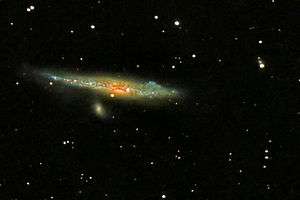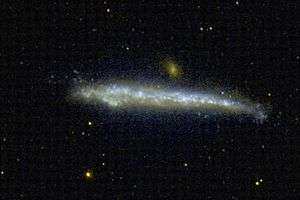NGC 4631
| NGC 4631 | |
|---|---|
|
| |
| Observation data (J2000 epoch) | |
| Constellation | Canes Venatici[1] |
| Right ascension | 12h 42m 08.0s[2] |
| Declination | +32° 32′ 29″[2] |
| Redshift | 606 ± 3 km/s[2] |
| Distance | 30 Mly |
| Apparent magnitude (V) | 9.8[2] |
| Characteristics | |
| Type | SB(s)d[2] |
| Apparent size (V) | 15′.5 × 2′.7[2] |
| Notable features | edge-on |
| Other designations | |
| Whale Galaxy,[3] UGC 7865,[2] PGC 42637,[2] Arp 281,[2] Caldwell 32 | |
NGC 4631 (also known as the Whale Galaxy or Caldwell 32) is a barred spiral galaxy in the constellation Canes Venatici. This galaxy's slightly distorted wedge shape gives it the appearance of a herring or a whale, hence its nickname.[3] Because this nearby galaxy is seen edge-on from Earth, professional astronomers observe this galaxy to better understand the gas and stars located outside the plane of the galaxy.
Starburst and superwind
NGC 4631 contains a central starburst, which is a region of intense star formation. The strong star formation is evident in the emission from ionized hydrogen[4] and interstellar dust heated by the stars formed in the starburst.[5] The most massive stars that form in star formation regions only burn hydrogen gas through fusion for a short period of time, after which they explode as supernovae. So many supernovae have exploded in the center of NGC 4631 that they are blowing gas out of the plane of the galaxy. This superwind can be seen in X-rays[6] and in spectral line emission.[4] The gas from this superwind has produced a giant, diffuse corona of hot, X-ray emitting gas around the whole galaxy.[7]

Nearby galaxies and galaxy group
NGC 4631 has a nearby companion dwarf elliptical galaxy, NGC 4627. NGC 4627 and NGC 4631 together were listed in the Atlas of Peculiar Galaxies as an example of a "double galaxy" or a galaxy pair.[8]
NGC 4631 and NGC 4627 are part of the NGC 4631 Group, a group of galaxies that also includes the interacting galaxies NGC 4656 and NGC 4657.[9][10][11][12] However, exact group identification is problematic because this galaxy and others lie in a part of the sky that is relatively crowded. Estimates of the number of galaxies in this group range from 5[9] to 27,[12] and all studies identify very different member galaxies for this group.
See also
- NGC 891, a similar edge-on spiral galaxy
- NGC 4565, a similar edge-on spiral galaxy
- NGC 5907, a similar edge-on spiral galaxy
References
- ↑ R. W. Sinnott, ed. (1988). The Complete New General Catalogue and Index Catalogue of Nebulae and Star Clusters by J. L. E. Dreyer. Sky Publishing Corporation and Cambridge University Press. ISBN 0-933346-51-4.
- 1 2 3 4 5 6 7 8 9 "NASA/IPAC Extragalactic Database". Results for NGC 4631. Retrieved 2006-11-21.
- 1 2 "SIMBAD astronomical database". Results for NGC 4631. Retrieved 2006-08-22.
- 1 2 R. J. Rand; S. R. Kulkarni; J. J. Hester (1992). "Warm ionized gas in the edge-on galaxies NGC 4565 and NGC 4631". Astrophysical Journal. 396: 97–103. Bibcode:1992ApJ...396...97R. doi:10.1086/171699.
- ↑ G. J. Bendo; D. A. Dale; B. T. Draine; C. W. Engelbracht; et al. (2006). "The Spectral Energy Distribution of Dust Emission in the Edge-on Spiral Galaxy NGC 4631 as Seen with Spitzer and the James Clerk Maxwell Telescope". Astrophysical Journal. 652 (1): 283–305. arXiv:astro-ph/0607669
 . Bibcode:2006ApJ...652..283B. doi:10.1086/508057.
. Bibcode:2006ApJ...652..283B. doi:10.1086/508057. - ↑ Q. D. Wang; R. A. S. Walterbos; M. F. Steakley; C. A. Norman; et al. (1994). "ROSAT detection of diffuse hot gas in the edge-on galaxy NGC 4631". Astrophysical Journal. 439: 176–184. Bibcode:1995ApJ...439..176W. doi:10.1086/175162.
- ↑ Q. D. Wang; S. Immler; R. Walterbos; J. T. Lauroesch; et al. (2001). "Chandra Detection of a Hot Gaseous Corona around the Edge-on Galaxy NGC 4631". Astrophysical Journal. 555 (2): L99–L102. arXiv:astro-ph/0105541
 . Bibcode:2001ApJ...555L..99W. doi:10.1086/323179.
. Bibcode:2001ApJ...555L..99W. doi:10.1086/323179. - ↑ H. Arp (1966). "Atlas of Peculiar Galaxies". Astrophysical Journal Supplement. 14: 1–20. Bibcode:1966ApJS...14....1A. doi:10.1086/190147.
- 1 2 R. B. Tully (1988). Nearby Galaxies Catalog. Cambridge: Cambridge University Press. ISBN 0-521-35299-1.
- ↑ P. Fouque; E. Gourgoulhon; P. Chamaraux; G. Paturel (1992). "Groups of galaxies within 80 Mpc. II - The catalogue of groups and group members". Astronomy and Astrophysics Supplement. 93: 211–233. Bibcode:1992A&AS...93..211F.
- ↑ A. M. Garcia (1993). "General study of group membership. II - Determination of nearby groups". Astronomy and Astrophysics Supplement. 100: 47–90. Bibcode:1993A&AS..100...47G.
- 1 2 G. Giuricin; C. Marinoni; L. Ceriani; A. Pisani (2000). "Nearby Optical Galaxies: Selection of the Sample and Identification of Groups". Astrophysical Journal. 543 (1): 178–194. arXiv:astro-ph/0001140
 . Bibcode:2000ApJ...543..178G. doi:10.1086/317070.
. Bibcode:2000ApJ...543..178G. doi:10.1086/317070.
External links
- APOD (2004-01-23) – The Whale Galaxy
- APOD (2010-05-17) – The Whale Galaxy (a better image)
- NGC 4631 on WikiSky: DSS2, SDSS, GALEX, IRAS, Hydrogen α, X-Ray, Astrophoto, Sky Map, Articles and images
- NGC 4631 at the SIMBAD Astronomical Database.
- Ids - Bibliography - Siblings - Image - B&W Image.
Coordinates: ![]() 12h 42m 08s, +32° 32′ 29″
12h 42m 08s, +32° 32′ 29″

